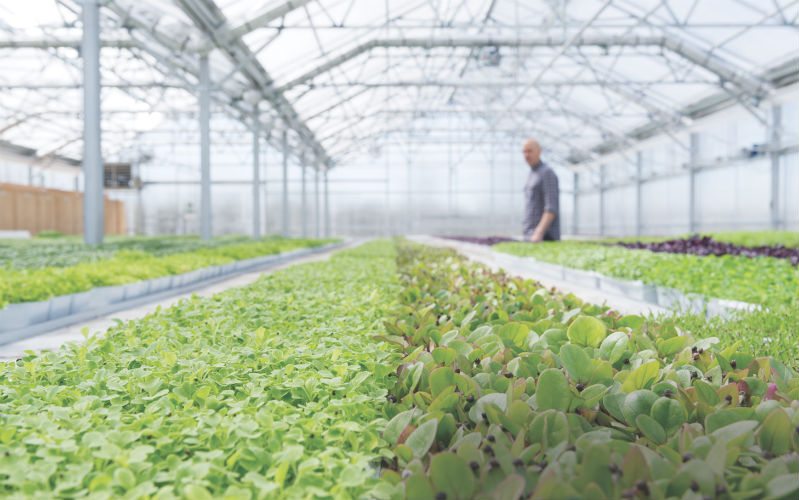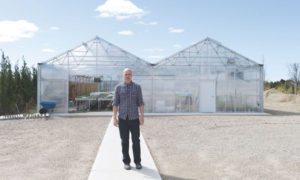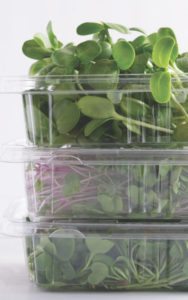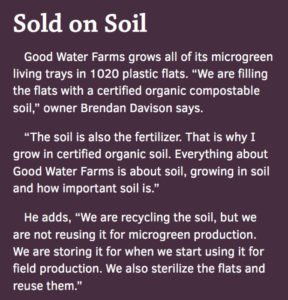
High on Growing Microgreens in Soil
Before moving from New York to California in the late 1990s, Brendan Davison didn’t have a lot of interest in growing plants. Once he started growing cannabis illegally in California he started to realize just how important plants are to healthy living.
“I was growing cannabis indoors under lights,” Davison says. “I acquired the skill of being an indoor grower without really realizing what I was doing. Besides growing cannabis I was also a big foodie and I was growing sunflower shoots. I was surrounded by the vegan, raw food movement in California.
I embraced the vegan lifestyle and saw the plant-based diet as really the only way for people and the planet to survive.”
Making the Move to Microgreens
Once Davison got married and had a child he realized that he needed to look for another job.
“I moved back to New York in 2005 and bought a small 7- by 11-foot greenhouse to produce sunflower shoots, which I sold locally,” he says. “I put it in the driveway of the house I was renting in Amagansett. When a friend of mine asked me what was the name of my business, I told him I didn’t have one. The English translation of Amagansett, which is an Indian name, means “place of good water” so I called my business Good Water Farms.
“In 2010 while I was selling sunflower shoots, I was at a restaurant in Manhattan and saw these tiny greens on some of the dishes. I asked the waitress what they were and she didn’t know so I asked her to find out from the chef. The chef came out and he told me that these were microgreens and that they were a new food trend. I asked him about how they were grown and he said he didn’t know.”

The next day Davison contacted Johnny’s Selected Seeds to see if the company could provide him with information about microgreens.
“I was buying my sunflower seeds from Johnny’s and when I called the company I asked whether they had any microgreens seed,” he says. “The company rep said, ‘Funny you should ask because we are about to launch a whole division for microgreens,’ and asked me if I would like to be a test grower. I said sure and they sent me samples of different varieties.”
“At the time, there really wasn’t a lot of information available on how to grow microgreens. So through trial-and-error I figured it out. I started growing microgreens for some local restaurants in my greenhouse.”
By the end of the summer 2012, Davison had run out of production space in his greenhouse so he moved to a warehouse in East Hampton, New York.
“I was renting 1,200 square feet of warehouse space and also put up a 20- by 40-foot hoop house on the side of the warehouse,” he says. “I started out with metal halide lights in the warehouse and switched to T5 fluorescent lamps. The fluorescents were better for microgreen production.”
From Warehouse to Greenhouse

As production space and sales continued to increase, Davison decided that it was time to find a business partner.
“I was in the warehouse for about three years,” he says. “In 2015, I found a partner who had a 32-acre plot of land in Bridgehampton, New York. We are in the process of scaling up the business, which includes two new 24- by 96-foot Nexus Vail greenhouses covered with polycarbonate. I decided on growing the microgreens in the greenhouse due to the sun. That was the main reason. I’m all about organics. The sun is the most sustainable light there is. I felt the microgreens were better grown in sunlight than in artificial light. We have a Wadsworth Step Up Control that controls temperature and humidity along with a Wadsworth energy curtain that is also used for shade.”
He continues, “I started growing in the greenhouse in November 2016. When we started we actually realized that some of the varieties were not doing well in the winter in the greenhouse because the temperatures were too cold at night. So we built some vertical tables with fluorescent lights in a loft in our barn. That was about 400 square feet. In the summer it is too hot in the barn so we aren’t growing at that time. We are only using that space during the winter. We are also considering adding some artificial light fixtures in the greenhouse for winter production.”
Expanding Product Mix and Customer Base
In the warehouse and hoop house in East Hampton, Davison was growing about 21 varieties of microgreens. He is now up to 33 varieties. Some of the best-selling varieties include red shiso, pea tendrils, three different basils (rosie, Genovese, Thai), radish and nasturtium.
“During the summer is the shortest production time when the growing conditions are ideal in regards to temperatures and sunlight. I can harvest sunflower sprouts and pea tendrils in six to seven days. Basils, fennel and red shiso are harvested every 18 to 24 days during the summer.”
Davison says, “Cilantro and basils are the most difficult to grow. Cilantro needs a lot of attention. It’s a very sensitive crop. But it’s not the only crop like that.”
All the chefs he works with are constantly asking him to grow other things. “At the moment it’s just microgreens because that’s the crop the greenhouse is set up for,” he remarks. “I could probably grow baby greens with the set up, but I’m just trying to keep up with the demand for microgreens. We’re not at full capacity, but we’re considering adding additional greenhouses.”
The reason Davison is looking to add production space is the change being made to his product offerings.
 “We are in the process of changing our packaging,” he said. “Most of my production has been based solely on living trays. We are going to be starting to get into cut product. The cut product will be for both restaurants and grocery stores. The cut product will help to open a different avenue with the restaurants. There is such a demand for cut product that we decided to go in that direction.”
“We are in the process of changing our packaging,” he said. “Most of my production has been based solely on living trays. We are going to be starting to get into cut product. The cut product will be for both restaurants and grocery stores. The cut product will help to open a different avenue with the restaurants. There is such a demand for cut product that we decided to go in that direction.”
Davison said about half of his business is to restaurants and produce distributors. He is also looking to expand sales to Whole Foods Market from a local to regional level.”
Good Water Farms is currently in 12 Whole Foods in the tristate (New York, New Jersey and Connecticut) area. “Jumping to the regional level I will be able to get into 90 stores,” he adds.
Even though Davison stopped producing cannabis when he moved back to New York, he definitely has an interest in growing the crop again if the right opportunity comes along.
“I would definitely consider growing cannabis here in New York,” he says. “I’m waiting for the right moment, the right situation. I’m studying the market and watching how it goes.”
“My partner and I were in the 11th hour applying for a permit in New York. We did apply for a permit and then decided against it. There were too many regulations and too many things to prevent businesses from making money. I’m watching on how the market unfolds and if the opportunity arises I will definitely take it.”
For more information on Good Water Farms, please visit www.goodwaterfarms.com or email info@goodwaterfarms.com.









 Video Library
Video Library 


















